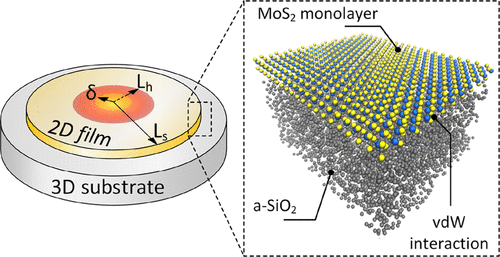当前位置:
X-MOL 学术
›
ACS Appl. Mater. Interfaces
›
论文详情
Our official English website, www.x-mol.net, welcomes your
feedback! (Note: you will need to create a separate account there.)
Toward Optimal Heat Transfer of 2D–3D Heterostructures via van der Waals Binding Effects
ACS Applied Materials & Interfaces ( IF 8.3 ) Pub Date : 2021-09-16 , DOI: 10.1021/acsami.1c08131 Lenan Zhang 1 , Yang Zhong 1 , Xin Qian 1 , Qichen Song 1 , Jiawei Zhou 1 , Long Li 2 , Liang Guo 2 , Gang Chen 1 , Evelyn N Wang 1
ACS Applied Materials & Interfaces ( IF 8.3 ) Pub Date : 2021-09-16 , DOI: 10.1021/acsami.1c08131 Lenan Zhang 1 , Yang Zhong 1 , Xin Qian 1 , Qichen Song 1 , Jiawei Zhou 1 , Long Li 2 , Liang Guo 2 , Gang Chen 1 , Evelyn N Wang 1
Affiliation

|
Two-dimensional (2D) materials and their heterogeneous integration have enabled promising electronic and photonic applications. However, significant thermal challenges arise due to numerous van der Waals (vdW) interfaces limiting the dissipation of heat generated in the device. In this work, we investigate the vdW binding effect on heat transport through a MoS2-amorphous silica heterostructure. We show using atomistic simulations that the cross-plane thermal conductance starts to saturate with the increase of vdW binding energy, which is attributed to substrate-induced localized phonons. With these atomistic insights, we perform device-level heat transfer optimizations. Accordingly, we identify a regime, characterized by the coupling of in-plane and cross-plane heat transport mediated by vdW binding energy, where maximal heat dissipation in the device is achieved. These results elucidate fundamental heat transport through the vdW heterostructure and provide a pathway toward optimizing thermal management in 2D nanoscale devices.
中文翻译:

通过范德华结合效应实现 2D-3D 异质结构的最佳传热
二维 (2D) 材料及其异质集成使电子和光子应用前景广阔。然而,由于众多范德华 (vdW) 界面限制了器件中产生的热量的消散,因此出现了重大的热挑战。在这项工作中,我们研究了 vdW 结合对通过 MoS 2 的热传输的影响-无定形二氧化硅异质结构。我们使用原子模拟表明,随着 vdW 结合能的增加,跨平面热导开始饱和,这归因于基板诱导的局部声子。凭借这些原子性见解,我们执行设备级传热优化。因此,我们确定了一种机制,其特征在于由 vdW 结合能介导的平面内和跨平面热传输的耦合,其中实现了器件中的最大散热。这些结果阐明了通过 vdW 异质结构的基本热传输,并为优化 2D 纳米级器件中的热管理提供了途径。
更新日期:2021-09-29
中文翻译:

通过范德华结合效应实现 2D-3D 异质结构的最佳传热
二维 (2D) 材料及其异质集成使电子和光子应用前景广阔。然而,由于众多范德华 (vdW) 界面限制了器件中产生的热量的消散,因此出现了重大的热挑战。在这项工作中,我们研究了 vdW 结合对通过 MoS 2 的热传输的影响-无定形二氧化硅异质结构。我们使用原子模拟表明,随着 vdW 结合能的增加,跨平面热导开始饱和,这归因于基板诱导的局部声子。凭借这些原子性见解,我们执行设备级传热优化。因此,我们确定了一种机制,其特征在于由 vdW 结合能介导的平面内和跨平面热传输的耦合,其中实现了器件中的最大散热。这些结果阐明了通过 vdW 异质结构的基本热传输,并为优化 2D 纳米级器件中的热管理提供了途径。











































 京公网安备 11010802027423号
京公网安备 11010802027423号